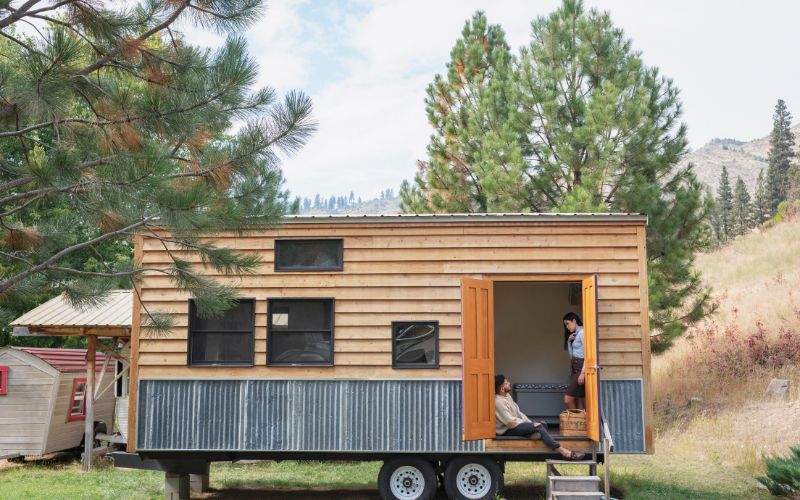You’ve decided to embrace minimalism and are considering a tiny home. That’s exciting! But before you leap, it’s essential to understand the factors involved. With this comprehensive guide, let’s delve into the considerations to ensure your transition to a smaller living space is as smooth and fulfilling as possible.

Purpose and Lifestyle
Understanding your purpose for downsizing and analyzing your lifestyle is vital when choosing a small house. Perhaps you’re seeking financial freedom, to reduce your environmental footprint, or embrace a more minimalist lifestyle. Identifying these goals upfront helps align your decision-making process with your aims. For instance, if environmental impact is your main concern, you might opt for a tiny home built with recycled materials.
Your lifestyle also plays a pivotal role. If you love to cook, a larger kitchen might be a priority. Or, if you work from home, your design might center around a dedicated workspace. The beauty of this kind of housing is that it can be customized to fit your unique needs and lifestyle. Finding the right tiny homes for sale can be a challenge, but considering your purpose and lifestyle will help narrow down your options and find the perfect fit. By considering your purpose and lifestyle, you can make informed decisions, ensuring your tiny home is a perfect fit for your life.
Size and Layout
The size of your tiny house should accommodate your daily activities without feeling cramped. Remember, every square foot counts in a tiny home, so it’s essential to consider how much space you genuinely need to live comfortably.
The layout, on the other hand, is about smart utilization of the available space. A well-thought-out layout can make a compact area feel spacious and functional. For example, an open floor plan can create a sense of spaciousness, while built-in storage can maximize utility. Ultimately, considering size and layout will help ensure your tiny home suits your needs and lifestyle, enhancing your overall living experience.
Utilities and Infrastructure
Even in small housing solutions, there are various utilities you must think about. These are the following:
- Electricity
- Water supply
- Sewage and wastewater
- Heating and cooling
- Gas or propane
- Internet and communication
- Trash and recycling
- Ventilation
- Lighting
- Safety systems
- Appliances
- Backup power source
Considering utilities and infrastructure is vital when choosing a tiny home as it directly impacts your quality of life. It determines the functionality of your home, affecting everything from cooking, and sanitation, to staying connected digitally. A careful evaluation of these factors helps ensure your tiny home is well-equipped, and comfortable and caters to your everyday needs efficiently.
Legal Considerations
Every region has specific zoning laws, building codes, and regulations concerning tiny homes, which can greatly influence your decision. Some areas may not permit tiny homes at all, while others may have strict requirements about their placement, size, or utility connections. Understanding these legalities upfront can save you from potential fines, litigation, or the need to relocate your home.
Moreover, it could also uncover opportunities – certain jurisdictions may offer incentives for sustainable or affordable housing. Legal considerations also extend to insurance and financing for tiny homes, which can be complex areas to navigate. Therefore, taking time to research and understand the legal landscape can help you choose a tiny home that is not only a perfect fit for your lifestyle but also compliant with local laws, ensuring a hassle-free living experience.
Also Read: Settle legally in Barcelona as a self-employed worker
Customization and Features
Customization offers the freedom to tailor your home to your exact preferences and needs. For instance, you might prefer a loft-style bedroom, a pull-out bed, or a ground-level sleeping area. Similarly, you might want to incorporate energy-efficient features, like solar panels, or luxury features like a compact dishwasher.
Considering these features and customization options in advance can help ensure that your tiny home is not just a place to live, but a home that genuinely reflects your personality, meets your lifestyle needs, and brings you joy. Therefore, it’s crucial to identify what features are most important to you and ensure they are included in your tiny home design.
Budget and Financing
By consciously planning your budget, you can prevent overspending and ensure your new home doesn’t impose financial stress. It’s important to factor in not just the initial cost of the house, but also ongoing expenses like utility bills, maintenance, and potential upgrades. Financing options, such as loans or mortgages, should be thoroughly researched to understand their implications.
While tiny houses often come with lower costs, unexpected expenses can emerge, so a contingency fund is prudent. Ultimately, detailed financial planning helps in making a sound investment, ensuring your tiny house brings joy without jeopardizing your financial well-being.
In your journey to embrace the tiny home lifestyle, remember that careful planning and consideration of these factors can transform your tiny house into a perfect abode for you. As you navigate through these stages, keep your lifestyle, goals, and budget at the forefront. Here’s to finding a tiny home that is an incredible fit for your life!